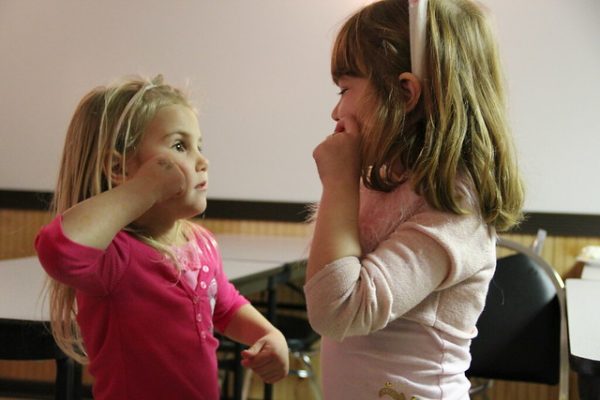
An elementary school student shows her younger friend how to sign using American Sign Language. Photo by daveynin, Flickr CC.
Since the passage of the Education for All Handicapped Children Act (EHA) in 1975 and the more comprehensive Individuals with Disabilities Education Act (IDEA) in 1990, the number of children receiving special education services has increased dramatically. Today, seven million children in the United States receive special education to meet their individual needs, with more than ever attending their neighborhood schools as opposed to separate schools or institutions.
Because special education has become so institutionalized in schools over the past three decades, we often take for granted that the categories we use to classify people with special needs are socially constructed. For instance, Minnesota has thirteen categorical disability areas, ranging from autism spectrum disorders to blind-visual impairment to traumatic brain injury. But these categories differ from state to state, as do states’ definitions for each category and their protocols for determining when a child meets the diagnostic criteria in a given area. A more sociological take suggests that the “special ed” label does more than just entitle children to receipt of services. For better or worse, it also helps to establish their position within the structure of the mass education system, and to define their relationships with other students, administrators, and professionals.
- Sally Tomlinson. 2012. A Sociology of Special Education. Routledge.
- Curt Dudley-Marling. 2004. “The Social Construction of Learning Disabilities.” Journal of Learning Disabilities 37(6): 482-489.
- Ray McDermott, Shelley Goldman, and Hervé Varenne. 2006. “The Cultural Work of Learning Disabilities.” Educational Researcher 35(6): 12-17.
Research suggests that children of color are overdiagnosed and underserved. They are more likely to be referred for special education testing and to receive special education services than others. This disproportionality occurs more often in categories for which diagnosis relies on the “art” of professional judgment, like emotionally disturbed (ED) or learning disabled (LD). It occurs less often in categories that require little diagnostic inference like deafness or blindness. The attribution of labels can be particularly concerning for children of color, as these labels can be associated with lower teacher and peer expectations and reduced curricular coverage. Even when appropriately placed in special education classes, children of color often receive poorer services than disabled white children. Some research suggests that this happens because the culture and organization of schools encourages teachers to view students of color as academically and behaviorally deficient.
- Carla O’Connor and Sonia DeLuca Fernandez. 2006. “Race, Class, and Disproportionality: Reevaluating the Relationship between Poverty and Special Education Placement.” Educational Researcher 35(6): 6-11.
- Daniel J. Losen and Gary Orfield. 2002. Racial Inequity in Special Education. Harvard Education Publishing Group.
- Beth Harry and Janette Klingner. 2014. Why Are So Many Minority Students in Special Education? Teachers College Press.
- Ellen Brantlinger, Robert Jimenez, Janette Klingner, Marleen Pugach, and Virginia Richardson. 2005. “Qualitative Studies in Special Education.” Exceptional Children 71(2): 195-207.
Given the disproportionate representation of students of color in special education, sociologists have investigated whether a child’s race or ethnicity elevates their likelihood of special education placement. By controlling for individual-, school-, and district-level factors, researchers have found that race and social class are not significant predictors of placement. However, school characteristics — like the overall level of student ability — play a role in determining who gets diagnosed. And, because children of color tend to be concentrated in majority-minority schools, they are less likely to be diagnosed than their white peers.
- Jacob Hibel, George Farkas, and Paul L. Morgan. 2010. “Who is Placed into Special Education?” Sociology of Education 83(4): 312-332.
You may also be interested in a previous article: “Autism Across Cultures.”
For more information on children and youth with disabilities, check out the National Center for Education Statistics.

Comments